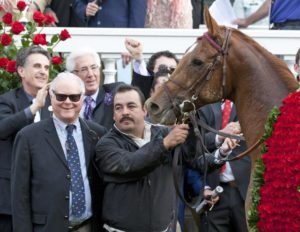To hear some tell it, I have been biting the hand that feeds me for more than 40 years. This has been pointed out to me over the years by a diverse group that includes Daily Racing Form publisher Mike Sandler, my DRF overseer Joe Hirsch, my current friend Ray Paulick back in an unenlightened incarnation when he edited The Blood-Horse, Hollywood Park’s director of publicity Bob Benoit and many others involved in the media.
My offense has been the unpardonable sin of washing the Thoroughbred industry’s dirty laundry in public. Somewhere along the line I made the mistake of thinking that just because I worked as a Turf Writer that I also was a journalist.
It wasn’t long before I was put squarely in my place by my supervisors. I quickly learned that I was nothing more than a shill for the house. The publications that I worked for were not set up to cover a beat like a real sportswriter, but to add some color in order to encourage participation, whether it was from horseplayers or owners or breeders.
Whether it was as a DRF columnist, writer for various magazines or as host of TV and radio programs, I tried to operate as a journalist would outside of racing in the “real world.” As long as my output was restricted within the confines of trades, subjects of my various endeavors only occasionally got worked up over it. But when I ventured out into general circulation media in a 1978 piece for Southern California-based New West magazine, all hell broke loose. The shit storm unleashed was, in its locale, as inflammatory as the industry response to the PETA/Asmussen/Blasi video.
My piece included such tidbits as trainers and jockeys holding horses to cash bets and jockeys exchanging betting information for illegal drugs, among other questionable practices. None of this was news to anybody that attended races in Southern California. These things were talked about every race day at the track. But where I made my mistake, according to those charged with maintaining the status quo, was to name names and to reach out to the general public. I had the bad taste to name the two biggest players in the game: Charlie Whittingham and Bill Shoemaker.
Johnny Longden became so incensed that at an HBPA meeting he called for my “license” to be revoked. (I had just started racing horses in my own name.) The Pumper calmed down after some worldly board members told him that what I wrote about the jockeys and drugs was the truth. It didn’t hurt my credibility that shortly afterwards the young rider of Spectacular Bid was arrested in the parking lot of Disneyland with a bag of cocaine.
Anyway, long story short, most of the stuff I wrote about was eventually corrected and I am convinced that my expose advanced the cause of racing, both for horseplayers and participants alike. Whittingham and Shoemaker eventually started cracking with first-time starters, for example.
Interestingly, few of those whose names I have referenced ever held any of this against me because they knew I was right and they were doing something that needed to be stopped. Whittingham subsequently trained for me, including a horse that we owned in partnership; Shoemaker rode for me; Longden became very friendly, and Hirsch and I became much closer after I moved on from the Form. If people realize that a journalist’s heart is in the right place, they respect him/her, not rail against them.
I only mention this to illustrate how long I have been involved in the industry debate over whether it is helpful to expose unsavory practices in hopes that by shining a light on them they can be corrected or whether it is better to sweep them under the carpet or deal with them privately.
We all know what PETA did. They sent in a mole that over a few months came away with some juicy video, which PETA turned into an edited production it disseminated. Without judging the quality or integrity of the product, it is safe to say that PETA apparently got what it wanted, which was to bring attention to the underbelly of the Thoroughbred racing industry. The question is what is the goal of PETA? Do they want to put us all out of business or cause enough of a public furor to generate changes in how we play the game?
At first I was upset because the video and New York Times article about the video were done in what I considered to be an unprofessional manner. But, with the passage of time, I now realize that only by adopting enterprising tactics and forcing racing’s hand is anything likely to move The Establishment off the dime.
I am aware of two incidents involving entrenched interests in racing that knew of illegal and unsavory practices that took place, which if handled in a more public manner, would have resulted in a cleaner sport today. But those involved chose to deal with the matters out of the glare of the spotlight.
I mention this because my initial thought about PETA was that if the organization really had the best interests of the horses at heart, they could have met privately with Asmussen and Blasi, showed them what they had discovered and perhaps worked out a deal with them to a) cease their unsavory practices, b) voluntarily suspend themselves or c) leave the game altogether.
Consider the case of two entities, one corporate and one governmental, that did exactly what I just referenced.
A high-ranking executive at a major racing association was tipped off that some jockeys were “plugging in” horses. Those in question all hailed from a locale known for producing riders that used battery devices to electrically stimulate horses. The exec knew a guy at the local FBI office. This exec asked G Man if he could help him, but requested that any evidence be shown only to him. He also asked that the agent not act on it in his official capacity at the FBI. With a few days, the agent produced audio, video and still photographic evidence showing that the tip was correct. The exec then met privately with the riders, read them the riot act and warned them that if they were ever caught with a joint, they would never ride at that track again.
Did it work? I seriously doubt it. Would it have worked for the racing association in question and residually for every other racetrack in the country if the revelation had gone public? You betcha. But the racing association wanted to keep this unsavory news out of the eye of the general and racing public. They didn’t want to air racing’s dirty laundry!
For many years a governmental agency charged with policing horse racing in a major locale had as its highest ranking non-political appointee a fellow with misguided judgment that took the law into his own hands, but as it turned out for the betterment of the miscreants and not the public. This guy, upon learning of positive test results for drugs, cut deals with perpetrators, issuing ineffective slaps on the wrists that failed to act as a deterrent. After the trainers realized that they could get away with murder, a drug culture was established in this formerly clean racing venue that to this day has not been eradicated.
The civil service employee actually thought that by keeping drug positives out of the public eye, he was helping the image of racing. But what he really did was sell out the sport, sell out the public and foster a blatant disregard for authority.
Selfishly, I established the Stanley Bergstein Writing Award a few years ago to encourage independent investigative journalism that would expose things in racing that needed a public airing in hopes that the result would be an improved image for racing.
Now more than ever, as our sport struggles to be relevant in a society that has had enough of animal abuse and drug abusers, we need writers with the ingenuity, savvy and talent to keep their eye on the ball and find platforms to publish their work. Because only by uncovering messes can the sport right itself.
(source: TDN)









